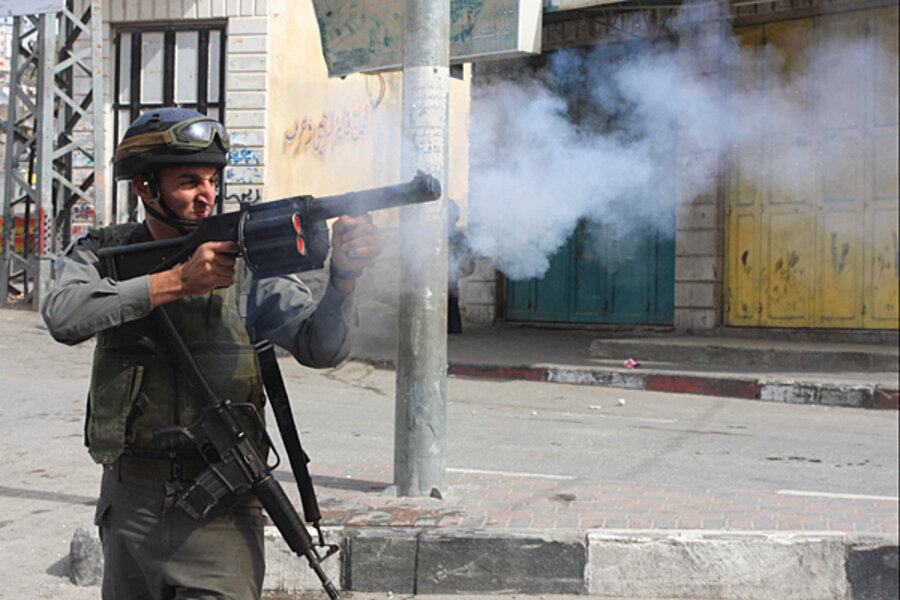Tensions spike after Israel names two West Bank sites to national heritage list
Loading...
| Jerusalem
Tensions continued to skyrocket Wednesday between Israel and the Palestinian Authority over Israel's decision to put two religious sites in the West Bank on its new heritage preservation list.
Israelis President Shimon Peres tried to rein in the rhetoric Wednesday, telling Robert Serry, United Nations Special Coordinator for the Middle East Peace Process, that Israel wasn't interested in "monopolizing" the sites and that it did not need "artificial conflicts" sparked by a "misunderstanding."
“Israel will continue to grant freedom of worship to every religion in every holy place," Mr. Peres said.
Clashes in the West Bank continued for the third straight day on Wednesday, following Sunday's decision by the Israeli government to add the two sites to list. In Hebron, clashes erupted between Palestinian youths and Israeli forces. Several Palestinians were injured, including a young boy and his mother, according to the Maan news agency in Ramallah.
An Israeli military spokesman said Palestinians hurled burning tires and rocks at soldiers, and that the rioters were dispersed. He said he could not confirm the injuries. An Israeli driving on a West Bank road was injured by a stone thrown at his car by local Palestinians, Israel Radio reported late Wednesday.
A day earlier, Palestinian Authority President Mahmoud Abbas warned that Israel’s decision to place the Cave of the Patriarchs in Hebron and Rachel’s Tomb in Bethlehem on the national heritage list could trigger a holy war. In Gaza, Hamas Prime Minister Ismail Haniyeh on Tuesday called on Palestinians to launch a new uprising against the measure.
That both the Israelis and the Palestinians lay claim to the very same sites of religious worship in the West Bank is not new. The Oslo Accords attempted to address the issue by promising continuing access to holy sites for all. But Israel's decision now to add the two sites to a national plan to renovate and improve the conditions of some
150 historical sites comes amid lack of progress in returning to negotiations.
The Cave of the Patriarchs in Hebron (sometimes called the Tomb of the Patriarchs), which both devout Muslims and Jews believe contains the remains of Old Testament prophet Abraham and his wife, Sarah, has been a flashpoint in the past. In 1994, Jewish settler Baruch Goldstein entered the Muslim side of the cave and killed 29 Palestinians worshiping there.
"Dynamite"
"This is playing with dynamite. The Israelis are perhaps not actually conscious of what they are doing," says Qaid Abdul-Karim, a member of the PLO's Central Council in Ramallah, which has strong influence over Abbas' decisions.
"Maybe the immediate reaction in the Palestinian side is not very violent, but sooner or later, the continuation of these provocations by the Israelis, including what they're doing in East Jerusalem, makes it harder to speak about peace or a peace process," says Mr. Abdul-Karim, who is also known as Abu Leila. "By encroaching on holy sites, they are not only committing an attack on Palestinian sovereignty and the two-state solution, they are also attacking the most sacred and sensitive spheres of Palestinian consciousness."
Palestinian and Israeli newspapers were full of speculation as to whether soaring emotions over the decision could provide the spark for a third intifada. Ben Caspit, a journalist for the Maariv newspaper, wrote that the decision to include the two sites was mostly symbolic, and came because of pressure on Netanyahu from the Israeli right-wing.
But past symbolic gestures have led to disaster, Mr. Caspit noted, pointing to the deadly riots sparked in 1996 when Netanyahu, prime minister then as now, allowed for the opening of a tunnel that leads from the Western Wall into the Muslim Quarter of Jerusalem's Old City. "After all, Netanyahu has already been in this story with the Western Wall tunnel. Then too, it was symbolic, pompous, and unnecessary," Caspit wrote.
Israeli and Palestinian negotiators have been reported for weeks to be close to agreeing to "proximity talks" as proposed by George Mitchell, the Obama administration's Middle East peace envoy. Officials on both sides suggested that hope is still in the offing, but shared concern that anger on the street could escalate, making talks that much more difficult.
What are proximity talks? Read this article.
"No decent Palestinian wants a third intifada, but what happens every day is driving the Palestinians crazy," Sufian Abu Zaida, a former cabinet minister in the Palestinian Authority, said in an interview with Army Radio.
Gen. (ret.) Giora Eiland, former Director of Israel's National Security Council, said he didn't think things would spiral further out of control.
"I'm not sure that it's the smartest thing in the world [for Netanyahu] to say that these areas will be part of Israel at this particular time," Eiland told foreign reporters at a briefing, when asked about the government's move. "But at the end of the day, Israeli statements are always confronted by Palestinian statements, but I don't think it has to grow into something much bigger than that."





